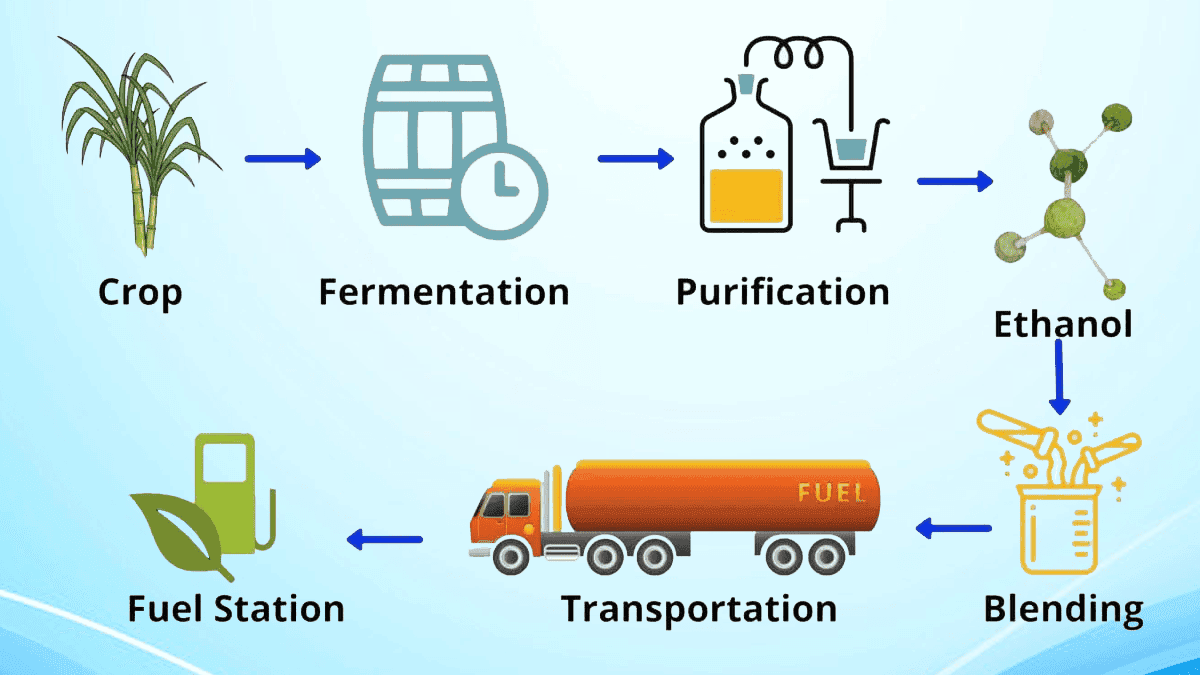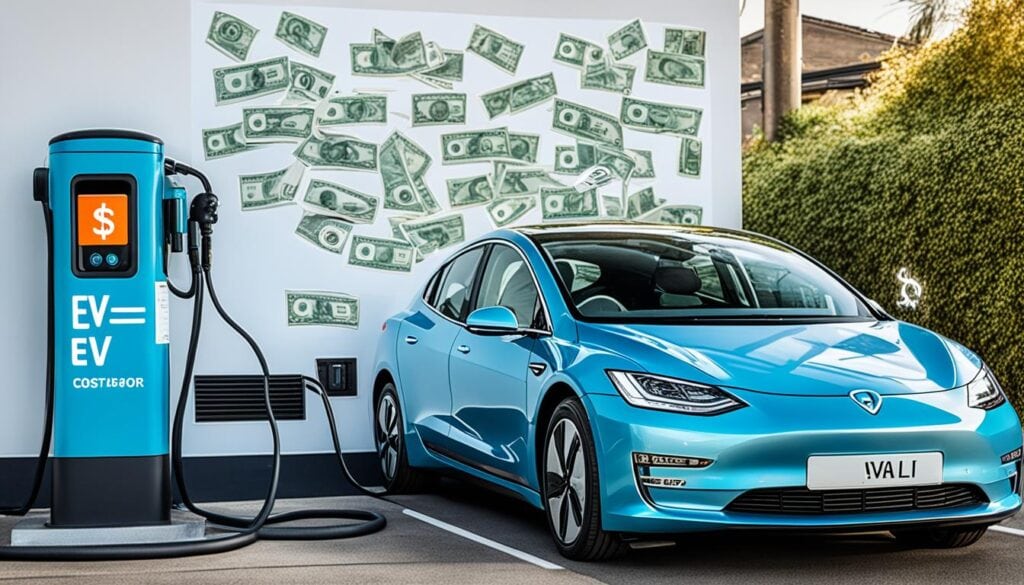The new E20 petrol policy is a new fuel mix comprising 20% ethanol and 80% gasoline. It’s a greener option for fuel. It utilizes renewable sources, such as corn and sugarcane. This blend is crucial to addressing India’s energy challenges, including reducing its reliance on fossil fuels and lowering emissions.

This article provides an in-depth examination of E20 petrol usage pros & Cons and a detailed study on engine code-wise compatibility. E10 to E20 retrofit action and cost benefits study.
We’ll examine how it’s made, its advantages, and its impact on cars and government regulations in India. Additionally, we will explore alternative options for non-compliant vehicles before April 2023 if necessary.
Key Takeaways
- New E20 Petrol Policy: E20 petrol is a blend of 20% ethanol and 80% gasoline.
- Cleaner combustion – Burns with fewer particulates, lower CO, NOx, and sulfur emissions.
- Renewable source – Produced from sugarcane, corn, or cellulosic biomass.
- Higher octane rating (~108 RON) – Reduces knocking, allows higher compression ratios in engines.
- Lower greenhouse gas footprint – Especially if sourced from sustainable crops.
- Mixability – Blends easily with petrol (E10, E20, E85 widely used).
🚗 Introduction to E20 Petrol: Automobile Industry Usage
- Flex-fuel vehicles (FFVs): Can run on any mix of petrol & ethanol up to E85 or E100.
- India, Brazil, and the US: Large ethanol blending programs (Brazil uses up to E100).
- Trend: Ethanol is seen as a bridge fuel—cleaner than petrol, renewable, but not as energy-efficient as petrol or as clean as EVs/hydrogen.
What is E20 Petrol and its composition?
E20 petrol mixes 20% ethanol with 80% petroleum. Ethanol is derived from plants and is considered an environmentally safe product. This mix improves fuel efficiency and reduces emissions.
Using E20 helps reduce our need for pure petroleum. It’s a step towards cleaner, greener transportation.
History and Development of E20 in India

India’s journey with E20 shows its commitment to green energy. The government’s E20 policy has been key, starting with the implementation of BS6-II norms in April 2023. These rules enhance fuel quality and support the goal of making E20 fuel widely available by 2025.
In India, E20 gasoline is part of a larger plan to increase the use of ethanol. This helps combat climate change and supports the global development of renewable energy. Learning about E20 petrol and its benefits helps you make a more informed choice for yourself and the planet.
Using E20 petrol is good for the planet. It reduces carbon dioxide emissions, making our environment greener. It also eliminates engine knocking, allowing your car to run more smoothly and last longer.
Which Petrol Engines are Compatible with E20 Petrol
🔧 E20‑Compatible Petrol Engine Codes in India
| Brand | Engine Code(s) | Displacement / Type | E20‑Ready From |
|---|---|---|---|
| Maruti Suzuki | K10C, K12N, K15C, Z12E | 1.0L 3‑cyl, 1.2L DualJet, 1.5L DualJet | Apr 2023 |
| Hyundai | Kappa 1.2 MPi, Kappa 1.0 T‑GDi, Smartstream 1.5 MPi | 1.2L NA, 1.0L Turbo, 1.5L NA | Apr 2023 |
| Honda | L12B, L15B, R15ZF | 1.2L i‑VTEC, 1.5L i‑VTEC | Jan 2009 |
| Toyota | 2NR‑FE, M20A‑FXS, G16E‑GTS | 1.5L NA, 2.0L Hybrid, 1.6L Turbo | 2023 |
| Tata Motors | Revotron 1.2T, Revotron 1.2 NA | 1.2L Turbo & NA | Feb 2023 |
| Mahindra | mStallion 1.2 TGDi, mStallion 2.0 TGDi | 1.2L Turbo, 2.0L Turbo | 2023 |
| Kia | Smartstream 1.2 MPi, 1.0 T‑GDi, 1.5 MPi | Same as Hyundai equivalents | 2023 |
| Skoda / VW | EA211 1.0 TSI, EA211 1.5 TSI | 1.0L Turbo, 1.5L Turbo | 2023 |
| MG Motor | 1.5L NA, 1.3L Turbo | Petrol & Turbo Petrol | 2023 |
| BMW | B38, B48, B58 | 1.5L, 2.0L, 3.0L Turbo | Already E25‑ready |
| Two‑Wheelers (select) | Honda eSP 110/125, Hero XTEC 110/125, TVS ET‑Fi series | Scooters & bikes | 2023 |
📌 How to Use This Table
- Check your RC or engine bay for the engine code (often stamped on the block or in the VIN plate).
- Match it with the table above.
- If your engine code is not listed or your vehicle is older than the “E20‑Ready From” year, stick to E10 petrol to avoid corrosion, seal damage, and performance loss.
🔄 E10 to E20 Retrofit Feasibility in India
| Engine Age / Type | Typical Issues with E20 | Retrofit Actions Needed | Feasibility | Notes |
|---|---|---|---|---|
| BSVI Phase 2 (Apr 2023+) | None — already E20‑ready | None | ✅ Direct use | Designed for ethanol‑resistant materials & ECU mapping |
| BSVI Phase 1 (Apr 2020–Mar 2023) | Minor seal/gasket wear over time | Replace fuel hoses, seals with ethanol‑resistant parts; ECU remap optional | ✅ With minor mods | Most OEMs can retrofit easily |
| BSIV (2010–Mar 2020) | Fuel pump corrosion, injector clogging, rubber degradation | Replace fuel pump, injectors, hoses, gaskets; ECU remap; check compression ratio | ⚠️ Moderate cost | Worth it only for newer BSIV models |
| Pre‑2010 (BSIII & older) | Severe corrosion risk, carburetor issues, poor cold start | Full fuel system replacement, carburettor re‑jetting, ignition timing changes | ❌ Not cost‑effective | Better to stick to E10 or replace the vehicle |
🛠 Key Retrofit Components
- Fuel System — ethanol‑resistant hoses, seals, gaskets, O‑rings
- Fuel Pump & Injectors — stainless steel or ethanol‑rated plastics
- ECU Remap — adjust for ethanol’s lower energy density & higher octane
- Cold Start Calibration — ethanol absorbs moisture, so cold starts can be harder
- Corrosion Protection — tank lining or stainless steel tank for older models
📉 Performance & Efficiency Impact
- Fuel Efficiency Drop: ~2–3% in newer engines, up to 6% in older ones
- Power Output: Often unchanged or slightly improved due to higher octane rating
- Maintenance: More frequent fuel filter changes (ethanol loosens deposits)
💡 Pro Tips Before Retrofitting
- Check with your OEM — some offer official E20 retrofit kits for BSVI Phase 1 cars.
- If your vehicle is BSIV or older, weigh retrofit cost vs. resale value.
- Always test with E15 first to monitor drivability and leaks before going full E20.
Ethanol Production Capacity Growth
While not direct production, capacity expansion gives context:
- As of November 30, 2023, India’s ethanol production capacity was ~1,380 crore litres per annum. The Hindu Down To Earth
- By mid-2025, capacity had climbed to ~1,810 crore litres annually. ETManufacturing.in BioEnergy Times
This ramp-up aligns with policy shifts, including diversifying feedstocks (molasses, broken rice, maize), offering interest subsidies, and scaling up distilleries.
Summary: Five-Year Production Trends
From ESY 2019–20 to ESY 2023–24 (fully complete years):
- Ethanol blended increased roughly fourfold: from ~173 crore L to ~707 crore L.
- Capacity followed suit, growing ~30% between late 2023 and mid-2025.
Here’s a snapshot:
- ESY 2019–20: ~173 crore L
- ESY 2022–23: ~500 crore L
- ESY 2023–24: ~707 crore L
- ESY 2024–25 (ongoing): Already ~749 crore L by July—expected to cross ~800 crore L.
Sources of Ethanol
The main sources of ethanol in India are sugarcane, corn, and other farm waste. These plants are key to India’s ethanol making. They help the car industry and also help farmers.
Manufacturing Process
Creating ethanol is a detailed process. First, sugars from plants are turned into ethanol in a controlled way. This ensures we obtain the maximum amount of ethanol possible.
This ethanol helps the car industry grow. It also opens up new chances for farmers. As ethanol production grows, the countryside will benefit significantly.
Advantages of E20 Petrol
E20 petrol offers many benefits for the environment, economy, and agriculture. It is a green alternative that can greatly help the environment and the economy.
Environmental Benefits
E20 petrol helps reduce environmental problems. It burns cleaner than traditional gasoline, reducing harmful emissions. This makes the air cleaner and healthier for everyone.
Economic and Agricultural Benefits
E20 also benefits the economy and farming. It reduces India’s need for oil imports, making energy more secure. It also creates a strong market for ethanol, helping farmers earn more money. This supports sustainable farming and boosts the economy.
| Aspect | Advantages |
|---|---|
| Environmental | Reduces greenhouse gas emissions, improves air quality |
| Economic | Decreases oil import dependency, enhances energy security |
| Agricultural | Supports sustainable farming, boosts farmers’ income |
Disadvantages of E20 Petrol
❌ Cons of Ethanol as a Fuel
- Lower energy density – Cars require ~1.5 times more ethanol than petrol for the same distance.
- Cold start issues – Ethanol vaporizes poorly in low temperatures, affecting ignition.
- Hygroscopic nature – Absorbs water from the air, which can corrode tanks/pipes.
- Food vs fuel Debate – Large-scale ethanol production competes with agriculture.
- Engine compatibility – Higher blends (E85, E100) need modifications (fuel system, seals, injectors).
Compatibility with Existing Engines
When using E20 petrol, car makers and mechanics need to make key adjustments. These changes affect engine parts and systems. They help mix ethanol with fuel smoothly.

Material and Component Adjustments
Using E20 petrol requires upgrading engine materials and parts. Fuel tanks, seals, and gaskets must be resistant to ethanol to prevent damage. Ethanol can harm some plastics and rubbers, so stronger materials are needed.
Fuel System Requirements
Switching to E20 petrol requires a change to the fuel system. Ethanol burns differently from pure petrol. This might mean replacing fuel injectors, pumps, and lines. These updates keep the fuel system working well and prevent damage.
Engine Calibration
Adjusting the engine control units (ECUs) is a key step for E20 engines. This fine-tunes the engine for ethanol. It ensures the engine runs well, saves fuel, and cuts emissions.

| Aspect | Petrol Engines | E20 Engines |
|---|---|---|
| Materials | Standard rubbers, plastics | Ethanol-resistant materials |
| Fuel System | Conventional injectors and pumps | Modified injectors and pumps |
| Calibration | Default settings | Recalibrated ECUs |
🔥 Burning Point (Ignition / Flash Point)
| Property | Ethanol (C₂H₅OH) | Petrol (Gasoline) |
|---|---|---|
| Auto-ignition temperature (Temp at which it ignites without flame) | ~365 °C | ~280 °C |
| Flash point (lowest temp where vapors ignite) | ~13 °C | ~–43 °C |
| Flame temperature in air | ~1920 °C | ~1977 °C |
| Energy density | ~27 MJ/kg (~21 MJ/L) | ~46 MJ/kg (~34 MJ/L) |
👉 Interpretation:
- Petrol ignites more easily (lower flash point & auto-ignition).
- Ethanol is safer to handle, since it requires a higher temperature to ignite and evaporates more slowly.
- Petrol has a higher energy density, meaning more power per liter compared to ethanol.
Government Policies on E20 Petrol
The Indian government has a big role in promoting E20 petrol. They have set clear guidelines and high standards. This helps make E20 a key part of India’s fuel mix.
These policies help move from old fuels to new ethanol-blended ones. It’s a big step towards a cleaner future.
Regulations and Standards
The government has made rules for E20 petrol. These rules cover ethanol content, quality, and safety. They make sure E20 petrol is good for performance, the environment, and health.
Implementation Targets
The government has set goals for mixing ethanol with petrol. They have a plan and rewards for meeting these goals. This makes the switch to E20 smooth and steady.
By doing this, the government shows it’s serious about using less fossil fuel. It’s all about moving towards cleaner energy.
Cost & performance: (E0/E10) vs E20

Today’s reference prices (Sep 2, 2025)
- Petrol pump MRP (Delhi): ~₹94.77/L. www.ndtv.comBusiness Today
- E20 at pump: Sold as regular petrol; not cheaper because average ethanol procurement cost ~₹71.32/L and has risen—OMCs say there’s no price advantage to pass through. Net effect: retail MRP broadly the same as petrol. Press Information BureauETInfra.com
Real-world fuel economy impact
- E20 fuel efficiency penalty: typically ~2–4% vs petrol (some estimates up to ~6–7% for older E0/E10-tuned cars; E20-tuned engines ~1–2%). NDTV Profit, Reuters, The Economic Times
- Performance feel: Higher octane from ethanol blending (E20 around RON ~95 fuel at pump) can improve anti-knock behaviour and slightly better acceleration in engines tuned for it. Press Information Bureau
Side-by-side: cost per 100 km & 5-yr fuel bill (Delhi price, baseline 18 km/L petrol car)
I’ve shared an interactive table (“E20_vs_Petrol_India_2025”) showing three scenarios (2%, 3%, 4% E20 mileage drop). Highlights:
- Per 100 km (baseline 18 km/L):
- Petrol: ~5.56 L ≈ ₹527/100 km.
- E20 (3% drop example): ~5.73 L ≈ ₹543/100 km (≈ ₹16 more per 100 km).
- 5-year / 75,000 km fuel cost:
- Petrol: ≈ ₹3.96 lakh.
- E20 (3% drop): ≈ ₹4.08 lakh → ~₹12k extra over 5 years (range ~₹8k–₹16k across 2–4% scenarios).
(See/download the full table above for all scenarios.)
Other ownership factors
-
Compatibility: From Apr 2025, new vehicles are E20-ready; older vehicles may be E10-calibrated, but most can use E20, with minor rubber/gasket replacements over time. Warranties/insurance remain valid. ETAuto.com Press Information Bureau
-
Emissions: Lifecycle GHG for ethanol can be ~50–65% lower than petrol, depending on feedstock; at E20, that translates (by proportion) to a meaningful net tailpipe+LC reduction at the fleet level. (This proportional estimate is an inference from the lifecycle figures.) Press Information
Conclusion
🚗 Cars
| Brand | Models | E20‑Compatible From |
|---|---|---|
| Honda | Amaze, City, Elevate, Jazz, WR‑V, BR‑V | Jan 1, 2009 onwards |
| Maruti Suzuki | Wagon R, Alto K10, Celerio, Ignis, S‑Presso, Swift, Dzire, Baleno, Fronx, Brezza, Grand Vitara, Invicto, Ertiga, XL6, Jimny, Eeco, Ciaz, S‑Cross | Apr 2023 |
| Hyundai | Venue, Exter, Grand i10 Nios, i20 (Std & N‑Line), Verna, Aura, Alcazar, Creta, Tucson | Apr 2023 |
| Tata Motors | Punch, Altroz, Tiago, Tigor, Nexon, Curvv, Harrier, Safari | Feb 2023 |
| Toyota | Glanza, Innova Crysta, Innova Hycross, Hyryder, Urban Cruiser, Fortuner, Hilux, Vellfire | 2023 |
| Mahindra | XUV 3XO, XUV 400, XUV 700, Thar, BE 6, Scorpio, Bolero | 2023 |
| MG Motor | Hector, Astor, Gloster | 2023 |
| Skoda | Kushaq, Slavia, Kodiaq, Octavia, Kylaq | 2023 |
| Volkswagen | Taigun, Virtus | 2023 |
| Kia | Seltos, Sonet, Carens, Carens Clavis | 2023 |
🔍 How to Check Your Vehicle
- Look for an E20 label inside the fuel lid or in the owner’s manual.
- Use the E20 Compatibility Checker for a quick search by model/year.
- If your car/bike is older than the listed year, it’s likely not E20‑ready — using E20 in such engines may cause corrosion, rubber seal damage, and reduced performance over time.
E20 petrol is a promising alternative fuel with big benefits for the environment, economy, and society. It can greatly reduce harmful emissions, help farmers by using ethanol, and make us less dependent on other countries for energy. This makes it a key player in making the car industry more green and sustainable.
But there are challenges to using E20 petrol widely. Cars need to be able to use it, fuel systems might need changes, and governments must make clear rules. Working together, governments, rule makers, and car makers can solve these problems. This teamwork is essential for a future with clean energy.
E20 petrol is important for a greener energy world. By tackling the challenges and using E20 petrol, India can lead the way to a more eco-friendly car industry. This focus on sustainability and new ideas will help E20 petrol succeed, benefiting our planet and economy.



